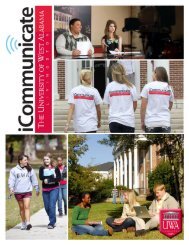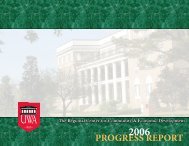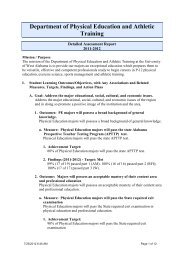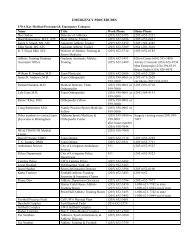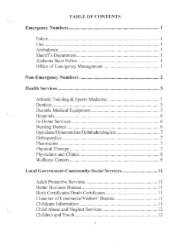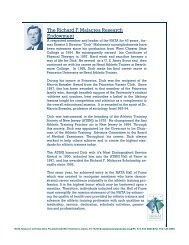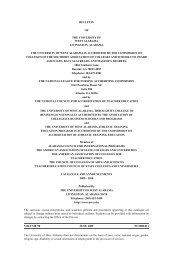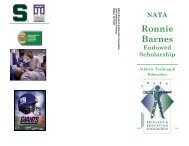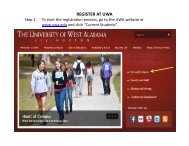table of contents - UWA Athletic Training & Sports Medicine Center
table of contents - UWA Athletic Training & Sports Medicine Center
table of contents - UWA Athletic Training & Sports Medicine Center
Create successful ePaper yourself
Turn your PDF publications into a flip-book with our unique Google optimized e-Paper software.
2. With the scene secure the athletic trainer should try to talk to the athlete. If the athlete is unresponsive then theathletic trainer should assume that the athlete has at least a head or spinal injuries and secure the c-spine. Ifother athletic trainers are present the athletic trainer with the most seniority will aid in the evaluation, alsoanother athletic trainer will go and activate the local EMS unit only at the request <strong>of</strong> the senior athletic trainer(on the scene).3. The athletic trainer holding the c-spine should be able to check or conduct a primary survey checking theairway, breathing, and circulation. The other athletic trainer(s) should start gathering information about theinjury from other players or witnesses.4. If the athlete is conscious and coherent the assisting athletic trainer should question the athlete about his/herinjury, i.e., what happened or what were you doing when, etc. The assisting athletic trainer should do asecondary survey while the athlete is talking.5. If possible find if the athlete has any predisposing factors, i.e., diabetes, previous heat problems, etc. Also, ifthe injury is not head or spinal cord related the athletic trainer holding the c-spine may release it only afterpermission from the most senior athletic trainer on site.6. The athletic trainer should always be aware <strong>of</strong> the possibility <strong>of</strong> the athlete going into shock at any time after aninjury no matter how minor the injury may appear, and the athletic trainer must be prepared to manage it. Theathlete should not be moved under most circumstances with the exception <strong>of</strong> heat illness.7. The athletic trainers evaluating and attending to the athlete should stay with the athlete and wait for theambulance to arrive and transport the athlete. Another athletic trainer should go to the entrance <strong>of</strong> the practicearea and wait for the ambulance to arrive and direct them to the scene. When the ambulance arrives, one <strong>of</strong> theathletic trainers will relay all information including vital signs, evaluation results, and any special problems tothe EMT's. Another athletic trainer should get the insurance and medical history information <strong>of</strong> the athlete.The athlete's insurance information is to be taken to the hospital by the athletic trainer riding with the athlete onthe ambulance.8. One athletic trainer is to ride in the ambulance with the athlete to the health care facility. Another will get thestate vehicle and follow the ambulance to the hospital.9. Always have someone contact the head athletic trainer or one <strong>of</strong> the senior athletic trainers immediately if theyare not on site.10. Never leave the scene unless another athletic trainer is on site to monitor the remaining athletes as the practiceor game continues.11. If it is a visiting team, assist the attending visiting athletic trainer however they deem appropriate withoutbreaking the above actions.Cheerleading Emergency Procedure (Anywhere on campus)1. When an injury occurs, the student athletic trainer should approach the athlete to evaluate the injury. If theinjury is life threatening the athletic trainer or student should have either the coach or another teammate go tothe nearest phone (undetermined at this time, due to daily changes in practice areas) or use an onsitecellular phone and activate the local EMS service and inform them <strong>of</strong> the emergency. Also, call the campuspolice and have them inform the head athletic trainer or one <strong>of</strong> the senior staff athletic trainers <strong>of</strong> the injury.He/she should then report back to the attending athletic trainer.2. While someone is enacting the EMS system the attending athletic trainer should do a primary survey and checkthe level <strong>of</strong> consciousness, if possible, or if the case <strong>of</strong> a head or spinal injury hold c-spine and wait. Afterenacting the EMS system and reporting to the attending athletic trainer, he/she should be instructed to help theattending athletic trainer by going and clearing a path to the injured athlete and directing EMS personnel to thescene. (There cannot be an established EMS route due to practice not restricted to one location)3. The attending athletic trainer must be aware that the athlete could go into shock at any time after an injury, so itis very important that the athletic trainer be able to recognize the early signs <strong>of</strong> shock and be able to manage it.The athlete should not be moved unless absolutely necessary.4. When the ambulance arrives at the field and the EMT's approach the athlete, the attending athletic trainershould give them all <strong>of</strong> the information gathered such as, the mechanism <strong>of</strong> injury, vital signs, time <strong>of</strong> injury,and progressing level <strong>of</strong> consciousness. When the ambulance is preparing to leave the athletic trainer shouldhave a copy <strong>of</strong> the athlete's insurance and brief medical outline to leave with the EMT’s. The attending athletictrainer should make sure they find out where the athlete is being taken. Once the ambulance has left, theattending student should relay the information to one <strong>of</strong> the senior staff athletic trainers.EMERGENCY PLAN RELATED INFORMATION56




